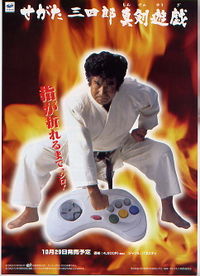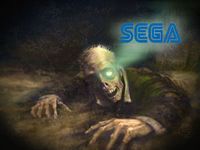Sega
The Sega Corporation (Japanese: 株式会社セガ Kabushiki Gaisha Sega) was part of Segata Sanshiro's master plan for the enslavement of adolescents. He hated how teens would go and spend their time outside playing sports or having sex, instead of locked away in a dark room playing video games. He decided to start a company that would promote video gaming, while he would punish those who squandered their time frolicking in the sun and fresh air.
History[edit | edit source]
Early struggles[edit | edit source]
Sega was founded based upon the premise that there is an inherent need to proliferate video gaming materials that were not made by the big red devil himself. Sega took the idea that it was their duty to do what the opposite of the devil would. While manufacturing arcade units and having some success in Japan, they attempted to penetrate the American market like a classic mighty dump truck with the Sega Master System. The Master System was designed to compete with the devil's dusty flashing gaming box and it failed miserably.
However, Sega saw a flaw in the devil's ways. He was an ancient devil that hated upgrading, forcing the same old dusty corroding box on the masses who would never know better. Sega decided that they saw a bright, fresh opportunity to forge a new beginning for the video game industry with them on top. Appropriately, they named the console the Mega Drive. Nonetheless, the U.S. patent office attempted to thwart Sega yet again by saying that the name Mega Drive was already taken. So, randomly, they renamed the console the "Sega Genesis".
Salvation[edit | edit source]
In 1991, Sonic the Hedgehog, started his mission on Earth. Through the prophet Yuji Naka, he was able to take Sega and do as he wished. Sonic the Hedgehog served as Sega's answer to Mario, the plumber who revolutionized the video game industry after Atari decided it wanted to oversaturate the market with subpar titles such as Eee Tee and Puck Man. Sonic gained market share by falling through the crack in the back of Mario's pants and became a force to be reckoned with. Sonic was edgy, cocky, and represented everything that Mario was not. Sonic begat a sequel after selling many Genesisses, Geneses, Genesi[1] and it became even more popular after issuing a mutant fox.
Nintendo, taking notices Sega's success, employed British developer Rare to develop colorful, cutting-edge 3D platformers like Donkey Kong Country, so that Sega would deplete its resources trying to compete.
Decline[edit | edit source]
Soon enough, Sega plagued the Genesis with the Sega CD, Sega CDX, Sega 32X, Sega Power Base II, Sega Neptune, and any other add-on that they thought would help them. Then they released some subpar games slapped Sonic on them and called it good. In short, Nintendo and its surrogate Sony decimated Sega.
Today, Sonic remains a mere shadow of himself, lurking at the glory days he once lived.
Products[edit | edit source]
Sega are renowned for many a console that has changed the course of history. These consoles are: Sega Genesis, Sega Saturn, Sega Game Gear, Dreamcast, Sega Spectrum, and Sega Pluto — most of which were discontinued after only two years on the market.
The unreleased Sega 64X would have included all of the 32X "features" but also an added blender designed specifically for "romantic milkshakes" along with 75% more cabling and power supplies. Unofficially, the objective was to have "a power supply for every man, woman, child, and horse on Earth."
Sega is known for making games and having a vast amount of intellectual properties including Streets of Rage, Golden Axe, Shinobi, Crazy Taxi, Shenmue, Garfield, Puyo Puyo, Ronald McDonald's Treasure Land, Scalarman, and Sesame Street Counting Cafe. However, despite having reached critical claim with these titles, they stuck with the anti-Mario known as Dankey Kang. Not to be confused with Dinkey Krong, Dankey Kang (also known as Sonic the Hedgehog by people who aren't smart enough to appear on Jeopardy) is Sega's flagship franchise. This is why Sonic 2006 received a 46 on Metacritic because people cannot appreciate the utter genius that Sega presents to the world through its quality titles. This is also why the other aforementioned franchises have not had releases outside Japan in years: they were not of Sonic 2006 and Sonic Boom quality.
Sonic Rush is most renowned of their games, but that is because it was secretly made by Shigeru Miyamoto, and everything that Shigeru Miyamoto touches is inherently the best thing ever. Luckily, it was released into the human world. The games plot deals with Sonic attempting to teach people the ways of the Cult of Sonic, but he is foiled by Dr. Eggman and Eggman's bastard son, Eggman Nega. Luckily for Sonic, he is helped out by his new co-star/furry sex symbol Blaze the Cat, who is good enough to be Sonic's sex slave because she is blazing hot, get it?
Idiocy[edit | edit source]
None other than the Sega Nomad shows Sega's idiocy. The Nomad, released in 1995, is on the same level of failure as the Virtual Boy or the game.com. Sega, in a last-ditch attempt to compete with the Pokemon playing machine, released the Nomad as a standalone portable console, taking significant liberties with the word "portable." Instead of playing downsized or "dumbed down" games like a traditional console, the Sega Nomad plays full-sized Genesis games. Yes, this actually happened. One literally sticks a Genesis game and plays it. Internally, it is a model 2 Sega Genesis. Aesthetically, it is a deformed brick that is no more pleasing, and even heavier than their first effort, the Game Gear. In fact, it's basically a Game Gear with 5 extra buttons and Genesis hardware inside instead of Master System hardware. Also, in an interesting design choice, the Nomad did not come with an internal battery compartment. Some speculate that this is due to the Nomad already being a bulking behemoth and that all that extra weight was unnecessary. Sega decided instead of using internal battery storage like every other portable ever, that they would release an external "battery pack" that will sear batteries alive in the matter of minutes.[2] Set at a retail price of $180, ($750 adjusted for inflation) the Sega Nomad was destined to failure, and as a result of the ludicrous idea of stuffing a Genesis in a huge brick, Sega lost more money.[3] Duracell was also furious over failure of their deal with Sega, which was dependent on the success of the Nomad.
Sonic Boom. No further explanation is necessary. Also Cranky Food Friends. Yet again, no further explanation is necessary.









